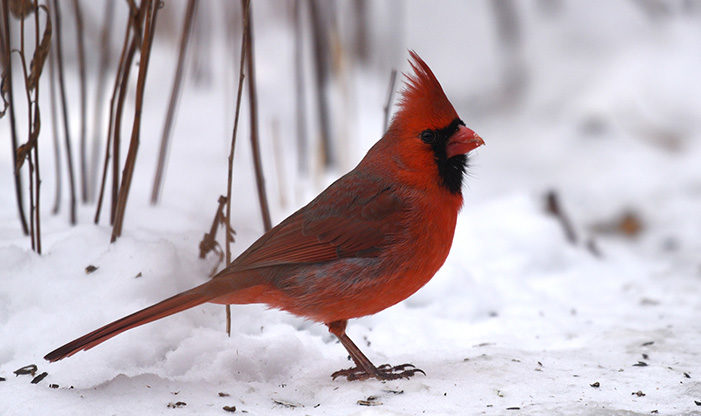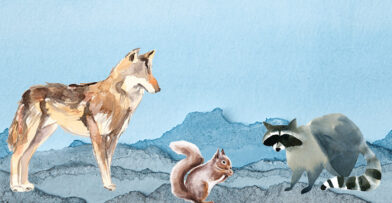Picture a crisp afternoon, the sun beginning to set over a chilled gray sky. Bare branches blend brown into white as snow covers the earth. Wind gently blows against a set of bird feeders, fully stocked with seeds. Suddenly, splashes of vibrant crimson descend onto the feeders, the red juxtaposed against the white snow. The birds, larger than sparrows but smaller than robins – with distinct crests atop their heads – begin foraging on the seeds. While other species camouflage in the branches, this bird stands out, a flaming beacon of the beauty that nature can behold. This common sight is the spark that leads many people down the path of bird watching. The bird at the gateway of this avian enthusiasm – the Northern Cardinal.
The Northern Cardinal (Cardinalis cardinalis) is one of the most recognizable songbirds in North America. Its native range has spread from the southeastern United States upwards as far as southeastern Canada and Northern Minnesota and as far West as the Great Plains and Southwest Deserts. A major aid in their spread North has been the abundance of sunflower seeds available to them at bird feeders. While they also consume insects, berries, and other vegetable matter, they favor sunflower seeds and will readily come to bird feeders all year long, as they are non-migratory. They are frequently observed foraging underneath feeders as well for dropped seeds.
Physical Characteristics of the Northern Cardinal
Northern Cardinals, like many songbirds, are sexually dimorphic. The males display bright red feathers, richly colored in all seasons, throughout their whole body with a bold black mask around their red beak. Females feature a more subdued and pale brown coloration with red tinges on their wings, tail, and crest. The females also have a more greyish black mask around their red beak. Both sexes feature a prominent feather crest atop their heads. Males are slightly larger than females. Cardinals are oftentimes the first at the feeders in the early morning, and the last in the evening. This could be due to their conspicuous colors being harder for predators to detect during lower light hours.
Northern Cardinals and Nesting
Differences in size and coloration are often evolutionarily linked to courting and nesting behaviors in birds. Northern Cardinals are thought to mate for life, and the pairs stay together all year long. There are instances of “divorce” if a pair is frequently unsuccessful in producing surviving offspring. The pair will separate to find more suitable mates. Early in the breeding season, males are often seen carefully feeding their female mates by passing seeds from his beak to hers in a kiss-like gesture. Pairs typically raise two broods together between March and September. During this time, males aggressively defend their nest and territory while bringing food to the female dutifully incubating the eggs. Nests are hidden in thickets of dense branching, typically in bushes and shrubs.
Chicks begin leaving the nest as early as seven days after hatching but are still fed by their parents for one to two months until they are driven out from the territory and begin flocking together. Once winter comes, pairs forego their territories to join the flock, so they can search for available food together.
Songs of the Northern Cardinal
Unlike many other songbird species, both male and female Northern Cardinals are adept singers. Females often sing from the nest, communicating their needs to their partners. Males sing more frequently during breeding season but will continue to sing throughout the rest of the year, making a bright and whistling “cheer cheer cheer…birdie birdie birdie” even in winter. A single Cardinal may develop more than a dozen song variations and flocks develop regional dialects. The sharp and metallic chip is the most common alarm and communication call, but over 16 different calls have been documented.
When visiting the Center, watch for Northern Cardinals frequenting the bird feeders near the Visitor Center, or perching in the leafless trees among all habitats. Listen for the whistling song or the sharp chirping call as they brighten up the cold winter days.


